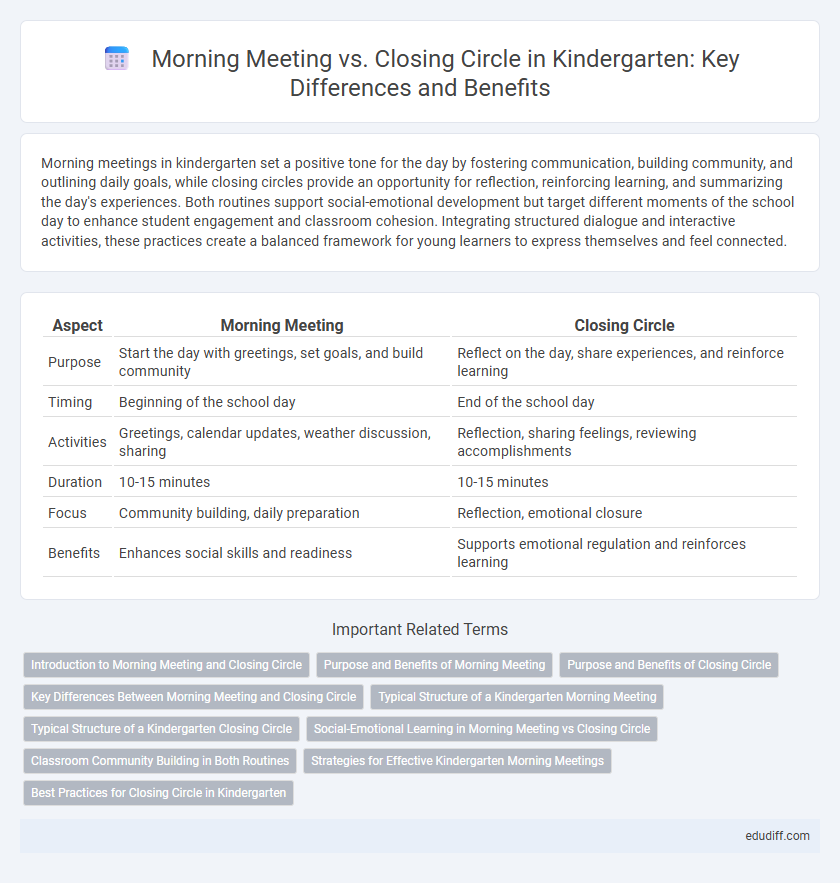Morning meetings in kindergarten set a positive tone for the day by fostering communication, building community, and outlining daily goals, while closing circles provide an opportunity for reflection, reinforcing learning, and summarizing the day's experiences. Both routines support social-emotional development but target different moments of the school day to enhance student engagement and classroom cohesion. Integrating structured dialogue and interactive activities, these practices create a balanced framework for young learners to express themselves and feel connected.
Table of Comparison
| Aspect | Morning Meeting | Closing Circle |
|---|---|---|
| Purpose | Start the day with greetings, set goals, and build community | Reflect on the day, share experiences, and reinforce learning |
| Timing | Beginning of the school day | End of the school day |
| Activities | Greetings, calendar updates, weather discussion, sharing | Reflection, sharing feelings, reviewing accomplishments |
| Duration | 10-15 minutes | 10-15 minutes |
| Focus | Community building, daily preparation | Reflection, emotional closure |
| Benefits | Enhances social skills and readiness | Supports emotional regulation and reinforces learning |
Introduction to Morning Meeting and Closing Circle
Morning Meeting in kindergarten establishes a structured start to the day, fostering social skills, emotional regulation, and community building through greeting rituals, sharing time, and group activities. Closing Circle provides an opportunity to reflect on the day's learning experiences, reinforce classroom routines, and prepare students for transition by summarizing key concepts and setting intentions for tomorrow. Both practices support developmental milestones by enhancing communication, cooperation, and classroom cohesion in early childhood education settings.
Purpose and Benefits of Morning Meeting
Morning Meeting in kindergarten fosters community building by creating a safe space where children share feelings, practice social skills, and set daily intentions. It enhances communication, promotes emotional regulation, and establishes a positive classroom atmosphere that supports learning readiness. This structured gathering encourages cooperation, boosts self-confidence, and aligns students with the day's goals, differentiating it from Closing Circle, which primarily reflects on the day's experiences.
Purpose and Benefits of Closing Circle
The Closing Circle in kindergarten serves as a reflective and calming activity that helps children process their day's experiences, reinforcing social skills and emotional development. This end-of-day routine promotes a sense of closure and community, encouraging children to share feelings and celebrate accomplishments. By fostering self-regulation and building positive relationships, the Closing Circle enhances overall classroom harmony and readiness for the next day.
Key Differences Between Morning Meeting and Closing Circle
Morning Meeting in kindergarten establishes a structured routine that fosters social-emotional learning through greetings, sharing, and setting daily goals, promoting a positive classroom environment. Closing Circle, held at the end of the day, focuses on reflection, summarizing learning experiences, and preparing children for transition to home or the next activity. Key differences include timing, purpose, and activities--Morning Meeting emphasizes engagement and goal-setting, while Closing Circle centers on reflection and closure.
Typical Structure of a Kindergarten Morning Meeting
Kindergarten Morning Meetings typically begin with a greeting, followed by a sharing time where children express thoughts or news, fostering communication skills and community building. The main activity often includes a calendar review, weather discussion, and introduction of the day's agenda to enhance cognitive understanding and classroom readiness. In contrast, the Closing Circle focuses on reflection, celebrating achievements, and setting intentions for the next day, emphasizing emotional development and closure.
Typical Structure of a Kindergarten Closing Circle
Kindergarten Closing Circle typically involves a calming routine that helps children reflect on the day's activities, share their feelings, and prepare for dismissal. This structure often includes a quiet song, a review of key lessons, and an opportunity for students to express gratitude or thoughts. The Closing Circle fosters a sense of community and reinforces social-emotional learning while providing a clear bridge to the transition home.
Social-Emotional Learning in Morning Meeting vs Closing Circle
Morning Meeting in kindergarten fosters social-emotional learning by creating a consistent, welcoming space for students to develop empathy, self-regulation, and communication skills through shared greetings and mindful check-ins. Closing Circle reinforces these skills by encouraging reflection on the day's experiences, promoting emotional awareness and group cohesion before dismissal. Both practices support emotional literacy and interpersonal relationships but Morning Meeting actively sets the tone for positive social interactions throughout the day.
Classroom Community Building in Both Routines
Morning Meeting sets a positive tone by fostering greetings, sharing, and group engagement, essential for building trust and a sense of belonging in the kindergarten classroom community. Closing Circle reinforces these connections by reflecting on the day's experiences, celebrating achievements, and promoting emotional expression, which strengthens social bonds and supports emotional development. Both routines collaboratively nurture a cohesive, supportive environment where children feel valued and connected.
Strategies for Effective Kindergarten Morning Meetings
Effective kindergarten morning meetings establish routines that foster social-emotional growth and build classroom community through consistent greeting, sharing, and interactive activities. Strategies include incorporating visual schedules to increase predictability, using songs and movement to engage young learners, and promoting turn-taking to develop communication skills. These practices set a positive tone for the day and support smooth transitions, enhancing both student participation and readiness to learn.
Best Practices for Closing Circle in Kindergarten
Closing Circle in kindergarten reinforces daily learning by encouraging reflection, sharing accomplishments, and setting goals for the next day. Best practices include using interactive songs, visual aids like storyboards, and fostering a supportive environment where each child feels valued. This routine strengthens social-emotional skills, promotes communication, and solidifies classroom community.
Morning Meeting vs Closing Circle Infographic

 edudiff.com
edudiff.com